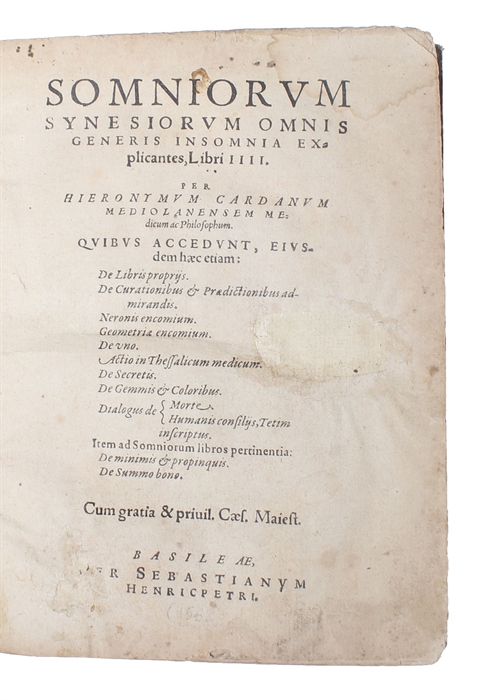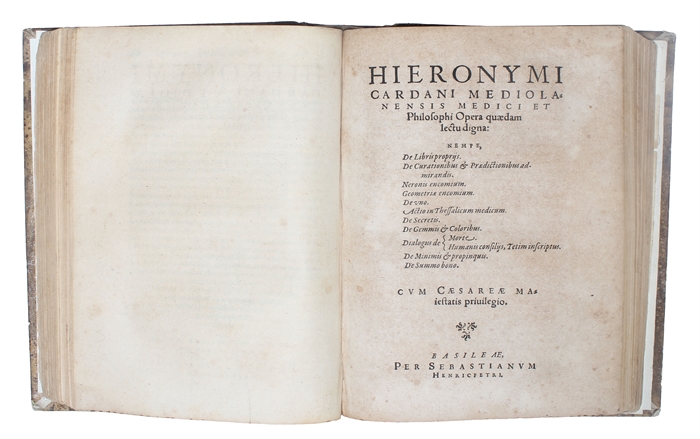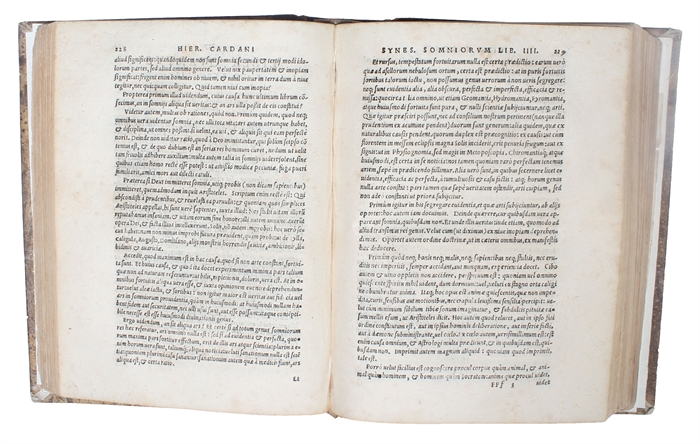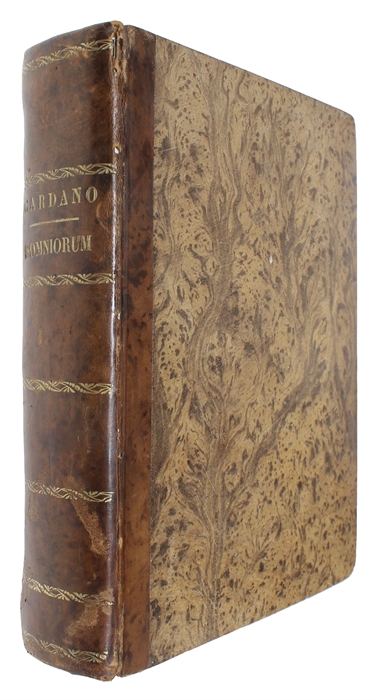THE MOST IMPORTANT RENAISSANCE WORK ON DREAMS
CARDANUS, HIERONYMUS.
Somniorum Synesiorum omnis generis insomnia explicantes, Libri IIII. Quibus accedunt, eiusdem haec etiam. De libris propijs. De Curationibus & Praedicationibus admirandis. Neronis encomium. De uno. Actio in Thessalicum medicum. De Secretis. De Gemmis & Coloribus. Dialogus de: Morte (&) Humanis consilijs, Tetim inscriptus. Item ad Somniorum pertinentia: De minimis & propinquis. De summo bono.
Balsel, Sebastian Henricpetrus, (1562). 4to. Both volumes bound in one nice mid-19th century half calf with gilt spine. Title to lower edge in contemporary hand. Ex libris to inside of front board. Some browning and brownspotting, and first title-page frayed at edges and with a repaired hole (presumably removing an old owner's name), not affecting printing and a small repaired hole in imprint (affecting the "Pe" of "Per Sebastianum...").
1) Somniorum Synesiorum: (42) pp., 1 blank leaf, 278 pp., 1 blank leaf. +
2) Opera quaedam lectu digna (with a separate title-page and separate pagination): (36), 413, (1, -errata) pp. - lacking the final leaf with printer's devise only (no text).
The extremely rare first edition of the most important Renaissance work on dreams, arguably the most important book on dream interpretation up until Freud. (Appended thereto as the second part of a collection of earlier works by Cardano, gathered here for the first time. This part lacks the leaf with the printer's device).
"Cardano is unusual among Renaissance writers on dreams, in that he both records a good many of his own dreams, displaying keen interest in them, and has a highly developed theory about the causation of dreams and the method of interpreting them. His book on dreams, "Somniorum Synesiorum Libri IIII", comprises an exhortation to interpret dreams, an account of how dreams are caused, classifications of them, advice on how to interpret them, and a final chapter describing fifty-five of his own dreams." (Alice Brown, Girolamo Cardanos's Somniorum Synesiorum Libri III, 1979).
Girolamo Cardano/Hieronymus Cardanus (1501 -1576) was an extremely important Renaissance polymath, being an influential mathematician, physician, biologist, physicist, chemist, astrologer, astronomer, philosopher, writer, - and gambler. He is often referred to as the greatest mathematician of the Renaissance and was one of the key figures in the foundation of probability as well as the one whointroduced binomial coefficients and the binomial theorem to the Western world.
His great work on dreams was also extremely influential and has always been considered of the utmost importance to the understanding of his scientific theories and world view. His theories about dreams are closely connected to his scientific theories about the world and bridges the gap of our understanding of his thoughts about certainty of knowledge. This great work on dreams, dream interpretation, and the cause of dreams, constitutes a fundamental attempt at understanding the mind and therefore the boundaries of our knowledge.
"Cardano admired experience and was a determined advocate of natural science. But at the same time he was aware of the insufficiency of empiricism and insisted upon the justice of the claims of mathematical reason. He even went so far as to stress that our knowledge can be protected against uncertainty only by the employment of a method that led from the one to the many. He held, however, that owing to the way in which the mind is tied to the body, the synthesis between reason and sensuous knowledge was most precarious and prevented a perfect understanding of those ideal and incorporeal essences which constitute the principles of bodies. It also makes it impossible for us to visualise adequately the original connections through which the separate things arise out of their principles. Our physical knowledge is a superficial knowledge. It makes us glide over things without probing their souls and is based upon analogies and parables... In short, Cardano was fully aware of the difficulty of the passage from the mental to the real, from ideas to things." (Eugenio Garin: Italian Humanism, 1965, pp. 188-89).
"Girolamo Cardano conceived and outlined his four books on dreams according to Synesius' philosophy between 1535 and 1537. Originally divided into ten books, the volume underwent subsequent modifications until it was published in 1562. We know from Cardano's own testimony how the key episodes in his life were always heralded or accompanied by dreams. From this point of view, the 1562 summa on dreams reflects one of the most critical of such moments. As Jean-Yves Boriaud explains in the introduction to his new Latin edition and French translation of Somniorum Synesiorum libri quatuor, in the year prior to the composition of this work, Cardano was undergoing intense dream activity as a result of the tragic execution in 1560 of his son Giovanni Battista, who had been charged with poisoning his wife. From that moment on, the death of his son would represent a watershed moment in both his life and literary career. For this reason, too, Somniorum Synesiorum libri quatuor deserves to be considered as one of Cardano's most important writings and Boriaud's edition should be saluted as a notable accomplishment. (Giglioni, Guido (2010) Synesian Dreams. Giacomo Cardano on dreams as means of prophetic communication. Bruniana & Campanelliana, XVI (2). pp. 575-584.).
The work is of the utmost scarcity. OCLC lists merely four copies: two in Switzerland, one in Germany, and one in The Netherlands.
Adams: C:692; Wellcome: I:1305.
Order-nr.: 52485




